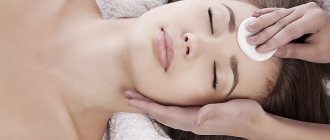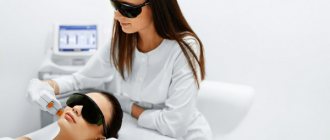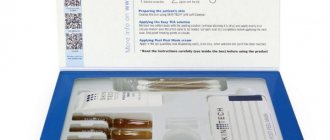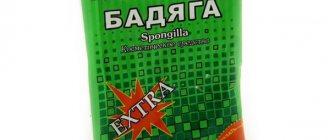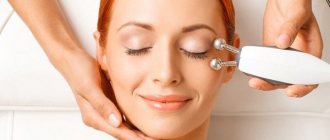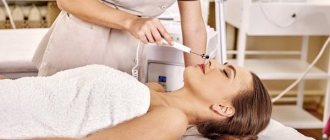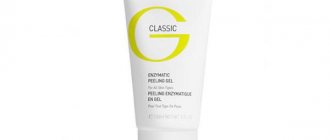Smooth, elastic skin and an even complexion are the main criteria for youth and beauty in any culture. Alas, not every person can boast of such natural wealth. And then it’s worth calling on modern cosmetology to help.
Today, one of the most effective and popular ways to cleanse and rejuvenate the skin is chemical peeling . “Rejuvenation without a scalpel” is what they say about this procedure, which helps get rid of a huge number of skin defects, including small superficial wrinkles.
The technique is aimed at eliminating imperfections in the skin of the face and body. As a result, the skin becomes smoother, its color is evened out, pigment spots, scars, stretch marks, post-acne become smaller or disappear altogether, and the function of the sebaceous glands is normalized. After the procedure, patients note an increase in skin tone and elasticity, smoothing of its relief, and the disappearance of small surface wrinkles. Reviews of chemical peeling, photos before and after the procedure posted on the Internet, speak in favor of this method.
Chemical peeling involves applying organic acids to the skin and dissolving the top layer of dead epidermal cells. Therefore, the procedure is also called acid peeling.
Of course, chemical peeling of the skin is a fairly radical method and can only be used by a knowledgeable and experienced dermatocosmetologist for serious indications.
1 ENERPEEL
2 Peel Tech Line
3 Inno Exfo Lightening
Deep peeling – what is it?
The deep peeling procedure has been known for a long time - it has been done in salons for more than 70 years. Previously, the main component was only phenol. Now oils are added to it to soften the skin and to reduce absorption into the blood, as well as glycerin and propylene glycol.
Each salon may have its own original recipe for such a composition, but phenol remains the main component.
In general, there are superficial, medium and deep peels; they differ in the depth of impact on the skin.
Superficial and medial are less traumatic than deep, so women should be especially careful if they decide to take this step.
The peeling procedure is a necessity for skin at different ages (from 30 to 55 years old), because it cleanses the skin and gets rid of dead cells. The basis of the procedure is the subsequent regeneration of the skin, its natural restoration and renewal.
Deep facial peeling allows you to get rid of not only dead cells, but also hyperpigmentation, small scars, wrinkles, and acne marks.
Indications for chemical peeling
Let's immediately figure out what age-related indications may be for chemical peeling:
- up to 25 years: treatment of problem skin, acne, acne vulgaris, prevention and treatment of molluscum contagiosum;
- 25-30 years: problematic skin, consequences of previous acne, treatment of actinic dermatitis and hyperpigmentation, prevention of skin aging.
- 30 years or more: treatment of hyperpigmentation of various etiologies, keratosis, correction and prevention of cosmetic skin defects (wrinkles, folds, aging skin), human papillovirus infection, preparation for skin plastic surgery and deep dermabrasion.
Peeling (3 stages)
It is better to entrust this procedure to specialists, as this is quite a serious manipulation.
The effect after deep peeling is truly amazing, as proven by the before and after photos - the skin becomes healthier, becomes younger, regeneration processes are accelerated, wrinkles and defects disappear.
It is worth noting that the procedure has contraindications and age restrictions, which will be described below, so before carrying out a consultation with a cosmetologist will be required!
It’s worth saying right away that not every woman can withstand deep chemical peeling, because it is a rather unpleasant and lengthy procedure that lasts at least 45 minutes (sometimes two hours).
During this manipulation, the facial skin is “burned out”, so the client may experience very painful and uncomfortable sensations.
It is possible to initially conduct the session under general anesthesia, otherwise the patient is sedated with strong painkillers.
For the safety of the patient, the patient must be connected to a cardiac monitor in the salon and an anesthesiologist must be present in the room.
If these services are not available for your deep chemical peel, consider finding another location for the procedure.
The session is carried out in several stages:
- Cleansing the skin with aggressive soap and a sponge, followed by alcohol degreasing.
- Now the phenol-based peeling mixture itself is applied. It is smeared onto individual areas of the skin, and then distributed evenly using a special device. This is done because the skin in different areas has a different structure, so it is important to observe the proportions of application of the drug.
- The skin is treated with medications that contain antibiotics, and they are also prescribed for oral administration.
Deep chemical peeling of the face is done no more than once a year. The frequency will depend on the condition of the skin and the patient himself, as well as on the doctor’s recommendations. Some doctors generally advise going for such manipulation only a couple of times in your entire life.
How does a chemical peel work?
During deep chemical peeling, all regeneration processes are actively stimulated and the upper layers of the epidermis are removed, which ultimately leads to an improvement in the condition of facial skin without surgical intervention. Chemical peeling is a radical procedure, so it is usually done only if there are serious problems: acne, oily problem skin, demodicosis, wrinkles and scars . In addition, chemical peeling is successfully used to prevent skin aging and correct age-related cosmetic defects, eliminate hyperpigmentation, and keratomas .
Result after peeling
The procedure can give truly stunning effects. It is most often carried out for the following purposes:
- improved blood circulation;
- regulation of the sebaceous glands on the face;
- removing dead cells that clog pores;
- lifting, elastin production;
- natural regeneration;
- rejuvenation;
- smoothing wrinkles and scars;
- getting rid of pigmentation.
Before deciding on exfoliation, the patient is recommended not only to consult a doctor, but also to undergo an examination in order to prevent all possible negative consequences. It is also important to trust good professionals, and not beginners in this matter.
Contraindications (6 restrictions)
Any medical procedure may have its contraindications, and exfoliation is no exception.
First of all, it is worth noting that chemical cleansing should not be carried out on women under 50-55 years of age, since at a young age the skin is thinner and more delicate and is easily damaged.
Contraindications:
- Heart disease or installed pacemaker;
- Kidney and liver diseases;
- Oncology;
- Pregnancy and lactation;
- Eczema and psoriasis, other dermatological diseases;
- Acne, acne.
It is precisely because of possible contraindications that the patient is recommended to undergo an examination initially.
The session is not recommended for women who have dark skin, since after recovery it will become noticeably paler compared to the general background, but this is not a contraindication, but only a recommendation.
The importance of preparation
A week before phenol peeling, you must start taking antiviral drugs (as prescribed by your doctor).
In general, it is impossible to prepare the skin for a third-degree burn, and this is exactly what will be obtained as a result. The only thing that can be done is to saturate the skin with useful substances as much as possible and undergo a series of special procedures, but they must also be prescribed by a doctor.
Make arrangements in advance for a vacation, at least for a couple of weeks. After the procedure, the face looks unattractive and it is advisable to simply be in the comfort of your own home at this time.
PROCEDURE OF THE “MEDIUM FACIAL PEELING” PROCEDURE
Under the influence of a medium facial peel, a white frost (resembling a frost coating) forms on the skin. The reason for this phenomenon is denaturation, or folding of proteins, as well as destruction of epidermal cells. A few hours after the procedure, the white frost will give way to redness and swelling, but after a couple of days the skin will return to its normal appearance. The patient should be informed about what to expect during the initial period after peeling. The psychological state of the latter during the rehabilitation period largely depends on how well the doctor “prepares” the client.
Recovery (important nuances)
After chemical exfoliation, the patient will have a third-degree burn and a crust will appear, which should never be touched with hands, this can lead to infection, inflammation and pigmentation.
This crust will peel off on its own in 10-15 days. It is mandatory to take antibiotics and anti-inflammatory drugs, but only as prescribed by the attending physician.
It is forbidden to be in the sun, sunbathing, or visiting baths and saunas. For the first three days, it is generally forbidden to even wash your face or brush your teeth - getting water on inflamed skin can be dangerous.
Results should not be expected immediately. Maximum effectiveness will be noticeable only after 2-3 months, not earlier.
Contraindications for peeling
Medium peeling should be avoided in patients with dark skin. In these patients, peeling may leave a permanently visible line of demarcation at the interface between the abraded and non-resurfaced skin. Medium peeling should not be performed on patients with damaged skin or areas of inflammation.
Peeling: seasonality
In the middle zone, the optimal time to perform a median peel is from September to March. And even at this time, the patient should avoid sunlight and use sunscreen on sunny days.
Advantages and disadvantages
The advantages include:
- Disappearance of wrinkles after procedures, noticeable tightening of the skin in problem areas.
- Correction of possible defects - scars, age spots.
If we talk about the disadvantages, here we can note the following:
- pain during the session;
- high likelihood of complications;
- long-term rehabilitation;
- the need to avoid ultraviolet rays for several months.
Question answer
No, blepharoplasty can solve this problem.
This is plastic surgery of the eyelids. The situation can be improved a little with the help of contour plastic surgery and microcurrent therapy. The fact is that it is at this time that the sun’s activity decreases, and the worn-out skin after manipulation is highly vulnerable to UV rays. As a result, you may encounter problems, such as pigmentation. But even in winter it is worth using sunscreen.
It differs for each person and can take up to six months.
Hardware cosmetology
Hardware laser peeling techniques:
- laser rejuvenation;
- ultrasonic;
- radio wave peeling.
Laser rejuvenation allows you to quickly get rid of skin defects - scars, age spots, acne, wrinkles.
This procedure is safe and effective, has virtually no contraindications or side effects, and all negative aspects are completely eliminated.
Ultrasonic peeling allows you to deeply cleanse the skin, rejuvenate it, and get rid of defects and wrinkles. Just like laser, it does not have any negative effects on the skin or the entire body as a whole - it is completely safe and most effective.
Radio wave peeling is based on post-traumatic tissue restoration. This procedure is safe and does not pose any complications or side effects.
After such manipulation, the skin becomes younger, deep wrinkles are smoothed out, and fine wrinkles disappear altogether.
Consequences
Complications often occur after deep peeling. If you take proper care of your skin, they will go away quickly.
How many times can you peel your face?
Peeling is a chemical, mechanical or hardware effect on the skin.
During the recovery period, the following side effects may occur:
- excessive peeling ;
- swelling – decongestant antioxidant ointments will help;
- rashes - a manifestation of an allergy to the drug used, can be relieved with antihistamines;
- pigmentation - as a result of non-compliance with the manipulation technique;
- hyperemia – due to drinking alcohol, spicy food, when playing sports or as a result of frequent stressful situations;
- scars and scars - when the cosmetologist incorrectly calculates the concentration of the substance used (treated with painkillers);
- penetration of infection .
In order to prevent the occurrence of these complications, it is important to strictly follow all the specialist’s recommendations and contact only trusted clinics.
Is it possible to perform peeling at home?
Deep facial peeling at home is impossible, because the procedure requires a thorough and professional approach, but there are several products that can replace the drug with phenol.
If you plan to do this process at home, be careful about the procedure.
Whatever products you use, be sure to test them on the crook of your elbow a day before - if an allergic reaction occurs, discard it.
You can carry out this peeling at home, but you should begin to carefully prepare the skin.
Cleansing will be carried out in several stages:
- Treatment with a disinfectant - bringing the skin to a normal acid balance.
- Application of the selected product (acid).
- Cleansing.
- Moisturize with a suitable cream.
You should not start peeling if the skin is not cleansed; you must strictly follow the entire sequence.
Remember about the possible unpleasant consequences that can remain on your face for life - scars, burns, etc.
The following remedies can be used at home:
- salicylic acid - makes the skin young, promotes regeneration and collagen production;
- glycolic acid - cleanses, moisturizes, makes more elastic;
- citric and mandelic acids;
- calcium chloride - deeply cleanses, allows the skin to breathe, promotes natural regeneration.
Such products can be purchased at a regular pharmacy or specialized cosmetic stores; there should be no problems with this.
If you decide to cleanse your face with calcium chloride, then it must be applied in several layers. Each layer must first dry.
For the first time you should not apply more than four layers, after which the number can be increased.
To remove such a mask, you need to lubricate your fingertips with baby soap and slowly roll calcium chloride off your face. Masks using acids are made according to the same principle.
Peeling at home will definitely not give the same results as salon procedures, but it is a good alternative when visiting such establishments is not possible. And they are much safer.
Execution steps
Only a highly professional specialist should perform deep peeling. The entire course of work is carried out in several sequential stages.
First, the cosmetologist removes dirt, remnants of decorative cosmetics and other contaminants from the skin. To do this, he uses disinfectant alcohol solutions.
Intimate area peeling
Intimate peeling is a procedure for women that is performed to rejuvenate the skin of the bikini area.
To reduce the severity of pain, the patient takes a sedative drug and a local anesthetic is injected.
A special brush is used to apply the chemical composition. It is important to correctly calculate the dosage of the product, especially if it is Phenol. The drug is applied to the face area in an uneven layer on some areas - densely, on others (more sensitive) - less, which avoids injury to them.
After the chemical reaction is complete, neutralization is carried out. As recovery progresses, peeling begins. The renewed layers will produce more collagen and elastane.
Next, all substances are removed, and a soothing cream is applied to the treatment area.
Additionally, the cosmetologist can apply a compress.
During the entire process, it is necessary to monitor the heart rhythm. If the arrhythmia increases, the procedure is stopped.
Price
The cost of such cleansing in each salon is individual; it also varies by city:
- Moscow from 3500;
- Rostov-on-Don from 3000;
- Tyumen from 2500.
On average, the cost of the procedure is about 3,000 thousand rubles, if you calculate the average price for Russian cities.
The price of deep chemical peeling will depend on several parameters - the prestige of the clinic, the doctor’s experience, the city.
Some clinics and salons do not provide this procedure. The reason is the high toxicity of the active substance. If you are planning to undergo a session, then you should worry about looking for a suitable institution in advance.
Reviews
If you are planning to undergo deep facial peeling, reviews will help you finally decide whether to do it or not.
CATHERINE:
“I had a deep peeling done at a trusted salon. I was pleased with the result, although the rehabilitation was long and difficult.
Afterwards, my skin became young, tightened, and I began to look like I was 40 when I was almost 60. An incredible result! It’s a shame that you can’t use this service often, but I’ll definitely come back here in the future.”
ANNA:
“I went through the procedure and was dissatisfied - the doctor was young and inexperienced, but at first I didn’t attach any importance to it.
Rehabilitation took 4 months, leaving scars that had to be removed with plastic surgery.
Advice - carefully select a medical institution and a doctor in particular, and then you can avoid a negative experience.”
ELENA:
“I have hyperpigmentation and fine age wrinkles.
After the procedure, all this became almost invisible. I won’t say that it disappeared completely, but the result is obvious. I was satisfied and recommend regular deep peeling after 60.”
CATHERINE:
“I have always suffered from an abundance of blackheads and acne scars.
After completing the session, I was amazed - they disappeared, this simply does not happen. I’m 56 years old, but I look 45. The procedure is painful, the recovery is long, but it’s worth it, believe me! For a few thousand you can look at least 10 years younger, isn’t that what every woman dreams of?”
VASILISA:
“I ordered the service from a fashionable clinic, but was disappointed with the result. It is very painful, takes a long time to heal, and the result is almost invisible. Perhaps I chose the wrong clinic or doctor.”
Expert opinion
- Cosmetologist
- Surgeon
Irina Dorofeeva
practicing cosmetologist
Most peelings are prescribed in courses. But this does not apply to the deep effects of acids. Most cosmetologists advise undergoing such a procedure once in a lifetime. The fact is that such peeling affects the deep layers of the skin. You cannot do this manipulation yourself; it must be performed by a highly qualified specialist. An alternative to chemical peeling is, for example, a laser procedure.
Heather Pechey
plastic surgeon
Deep peeling is a complex procedure and can be compared to some extent with surgery.
I strongly recommend going only to reputable clinics. In addition, prepare for a long rehabilitation period, as you will get burned. This procedure is suitable for older women over 55 years of age. It is traumatic and painful. I would advise you to think 100 times whether deep peeling is worth it, or perhaps it is better to look for other rejuvenation options. Deep peeling is a serious cosmetic method of rejuvenation. After it is carried out, serious consequences await a person, for which it is worth preparing in advance. If you nevertheless decide to undergo this procedure, find a good specialist. Otherwise, you risk getting into trouble.
Clinical manifestations of various types of peeling
With superficial chemical peeling, clinical manifestations are very scarce. Since cell damage extends only to the stratum corneum of the epidermis (the layer of dead cells), no crusting occurs and the skin surface is dry. Minor erythema may be noted immediately after the procedure. In subsequent days, patients note moderate peeling of the skin.
Medium chemical peeling always affects the layers of living cells of the epidermis. It is characterized by a “frost” effect (frost effect) - a solid white film over the entire surface of the skin exposed to acid. The “frost” effect is due to the denaturation of the protein structures of living epidermal cells.
Subsequently, a dense crust forms in the peeling area, which gradually peels off over 7-10 days. After complete exfoliation, moderate erythema persists for 2-3 weeks.
With deep peeling, damage occurs not only to all layers of the epidermis, but also to the tops of the papillae of the papillary dermis. In this case, multiple pinpoint hemorrhages and leakage of tissue fluid are noted. The subsequently formed scab comes off on its own within two weeks. The duration of erythema is several months.

